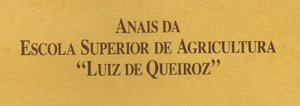Resumos
Através da técnica de eletroforese de gel de amido com migração horizontal, pode-se observar que para esterase, apenas o Amaranthus hybridus tipo verde apresentou variação, na forma de presença ou ausência da banda na posição 0.7. Por outro lado, para peroxidase, para todas as espécies e biótipos (A.viridis e A.hybridus tipo verde e tipo roxo) houve variação no padrão de bandas. Através da existência de bandas comuns às duas espécies, pode-se detectar evidências de hibridação e introgressãc entre elas.
eletroforese; isoenzima; esterase; peroxidase; Amaranthus; hibridação; introgressão
Through starch gel electrophoresis with horizontal migration, Amaranthus hybridus green biotype was the only accession to show variation in esterase patterns, with presence or absence of a band in position 0.7. On the other hand, all species and biotypes (A.viridisand A.hybridus green and purple biotypes) showed variation in banding patterns for peroxidase. Through the existence of common bands to both species, one could detect evidence for hybridization and introgression between them.
electrophoresis; isozyme; esterase; peroxidase; Amaranthus; hybridization; introgression
BIOQUÍMICA BIOCHEMISTRY
Caracterização preliminar de Amaranthus hybridus L. e Amaranthus viridis L. através de isoenzimas
Preliminary characterization of Amaranthus hybridus L. and Amaranthus viridis L. through isozymes
Angela Maria MalufI; Paulo Sodero MartinsII
IInstituto de Botânica, Caixa Postal, 4005, São Paulo-SP - CEP 01015
IIDepartamento de Genética, ESALQ/USP, Caixa Postal, 83 - PIRACICABA - SP - CEP 13400
RESUMO
Através da técnica de eletroforese de gel de amido com migração horizontal, pode-se observar que para esterase, apenas o Amaranthus hybridus tipo verde apresentou variação, na forma de presença ou ausência da banda na posição 0.7. Por outro lado, para peroxidase, para todas as espécies e biótipos (A.viridis e A.hybridus tipo verde e tipo roxo) houve variação no padrão de bandas. Através da existência de bandas comuns às duas espécies, pode-se detectar evidências de hibridação e introgressãc entre elas.
Termos para Indexação: eletroforese, isoenzima, esterase, peroxidase, Amaranthus, hibridação, introgressão
ABSTRACT
Through starch gel electrophoresis with horizontal migration, Amaranthus hybridus green biotype was the only accession to show variation in esterase patterns, with presence or absence of a band in position 0.7. On the other hand, all species and biotypes (A.viridisand A.hybridus green and purple biotypes) showed variation in banding patterns for peroxidase. Through the existence of common bands to both species, one could detect evidence for hybridization and introgression between them.
Index Terms: electrophoresis, isozyme, esterase, peroxidase, Amaranthus, hybridization, introgression.
Texto completo disponível apenas em PDF.
Full text available only in PDF format.
Trabalho entregue para publicação em 06.11.89
Trabalho aprovado para publicação em 25.02.91
- ATKINSON, M.D.; WITHERS, L.A.; SIMPSON, M.J. A. Characterization of cacao germplasm using isozime markers; 1. A preliminary survey of diversity using starch gel electrophoresis and standardisation of the procedure. Euphytica Wageningen, 35:741-50, 1986.
- BREWBAKER, J.L.; UPADHYA, M.D.; MAKINEN, J.; MAC DONALD, T. Isoenzyme polymorphism in flowering plants; III. Gel electrophoretic methods and applications. Physioloqia Plantarum Lund, 21:930-40, 1968.
- COLLINS, W.J.; ROSSITER, R.C.; HAYNES, Y.; BROWN, A.H.D; MARSHALL,D.R. Identification of subterranean clover cultivars and their genetic relationship by isozyme analysis. Australian_Journal_of Agricultural Research, Melbourne, 35:399-411, 1984.
- COONS, M.P. O gênero Amaranthus em Minas Gerais. Experientiae Viçosa, 27:1-158. 1981.
- DAMANIA, A.B.; PORCEDUU, E.; JACKSON, M.T. A rapid method for the evaluation of variation in germplasm collections of cereals using polyacrilamyde gel electrophoresis. Euphytica, Wageningen, 32:877-83, 1983.
- HAUPTLI, H. & JAIN, S. Genetic structure of landrace populations of the New World grain amaranths. Euphytica, Wageningen,33 : 875-84, 1983.
- HAUPTLI, H. & JAIN, S. Allozyme variation and evolutionary relationship of grain amaranths (Amaranthus spp). Theoretical and Applied Genetics, Berlin, 69:153-65, 1984.
- HUSSAIN, A.; RAMIREZ, H.; BUSHUK, W.; ROCA, W. Field bean (Phaseolus vulgaris L.) cultivar indentification by electrophore-grams of cotyledon storage proteins. Euphytica Wagening, 35: 729-32, 1986.
- HUSSAIN, A.; RAMIREZ, H.; BUSHUK, W.; ROCA, W. Identification of cultivars of forage legume (Desmodium ovalifolium Guill. et Perr.) by their electrophoretic patterns. Canadian Journal of Plant Science, Otawwa, 67:713-7, 1987.
- JAIN, S.K.; WU, L.; VAIDYA, K.R. Levels of morphological an allozyme variation in Indian amaranths: a striking contrast. Journal of Heredity, Washington, 71:283-5, 1980.
- MARCON. G. Estrutura genética de populações de Stylosanthes humilis H. B. K. (Leguminosae) de três regiões ecogeográfi-cas do Estado de Pernambuco. Piracicaba, 1988. 179p. (Doutorado - Escola Superior de Agricultura "Luiz de Queiroz"/USP).
- MARTINS, P.S. & JAIN, S.K. Interpopulation variation in rose clover: a recently introduced species in California range-lands. Journal of Heredity, Washington, 71:29-32, 1980.
- RITLAND, K. & JAIN, S. A comparative study on floral and electrophoretic variation with life history variation in Limnanthes alba (Limnanthaceae) . Oecolocfia Berlin, 64:243-51, 1984.
- SCANDALIOS, J.G. Genetic control of multiple molecular forms of enzymes in plants. Biochemical Genetic, New York, 3:37-39, 1969.
- SCHWAEGERLE, K.E.; GARBUTT, K.; BAZZAZ, F.A. Differentiation among nine populations of Phlox. 1. Electrophoretic and quantitative variation. Evolution Lancaster, 40:506-17, 1986.
- ZANGERL, A.R. & BAZZAZ, F.A. Effects of short-term selection along environmental gradients on variation on population of Amaranthus retroflexus and Abulilon theophrasti. Ecology, Brookling, 65:207-17, 1984a.
- ZANGERL, A.R. & BAZZAZ, F.A. Niche partitioning between two phosphoglucoisomerase genotypes in Amaranthus retroflexus. Ecology, Brookling, 65:218-22, 1984b.
Datas de Publicação
-
Publicação nesta coleção
06 Maio 2009 -
Data do Fascículo
1991
Histórico
-
Aceito
25 Fev 1991 -
Recebido
06 Nov 1989

